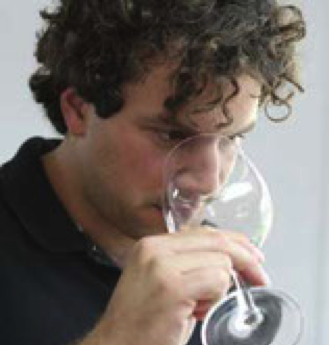Tannin Additions in Red Hybrid Wines
Tannin is to red wine what acidity is to whites: a backbone. Without either, it is difficult to make a balanced wine. This is one of the first principles I learned about winemaking (from Wine for Dummies, believe or not.)
Tannins are such an integral part of dry red wines that the renowned French enologist, Emile Peynaud, included tannins as one leg of his three-part (tripartite) model for a balanced dry red wine — the other parts being acidity and alcohol. In the Midwest, the low tannin content of red hybrids is one of the major challenges facing winemakers who seek to craft a dry red wine aimed at consumers whose palates favor vinifera wines.
Briefly, wine tannins are derived from two different sources: fruit and oak. Fruit tannins can be found in the skin, seed, and stems (if whole cluster fermenting) of grape clusters and are referred to as condensed tannins or proanthocyanidins.
Oak tannins differ in chemical composition, and are referred to as hydrolysable tannins. Overall, tannins are responsible for astringency in wine, the tactile sensation that imparts structure, body and mouthfeel wine characteristics. Tannins also play a secondary role acting as lifeboats for color compounds (anthocyanins) to glom onto during the aging process — hence improving the color stability of wines. (A more comprehensive review of tannin nomenclature and general chemistry is beyond the scope of this column; consult any general Enology textbook for more information).
If wine is simply a product of genetics and environment, then it appears as though we hybrid winemakers are at a genetic predisposition relative to our vinifera counterparts. In a survey study of West Coast vinifera wines, the mean tannin concentration was 544 mg/L of catechin equivalents (CE) as measured by protein precipitation method (Harbertson et al. 2008). In comparison, red hybrid wines have recently been reported below < 100 mg/L (Sun et al. 2011, Sun et al. 2012, Scott Laboratories).
While the discrepancy is obvious, we are only beginning to understand the reasons for lower tannin levels in hybrid wines. First, according to Dr. Gavin Sacks, associate professor at Cornell University, biosynthesis in hybrid grapes is significantly lower in both skin and total tannins relative to vinifera grapes. However, he notes this reduction alone does not account for the markedly reduced levels found in hybrid wines.
Further preliminary research from both Dr. Sacks and Dr. Anna Katherine Mansfield, assistant professor of enology at Cornell University, has shed some light as to why tannins are lower in hybrid wines relative to their vinifera counterparts. The leading theory is that hybrid grape solids (most likely certain cell wall constituents) are able to somehow bind and retain more tannin than vinifera (on a weight/weight basis), leaving red hybrids wines with less extracted fruit tannin. In other words, of what little tannin is available, even less is extractable into wine. As to why this is true, we will have to wait and see what researchers like Dr. Sacks and Dr. Mansfield discover.
So, what are we as vintners of hybrids supposed to do? Breeding red varieties with the appropriate grape chemistry, cold hardiness, disease hardiness, etc. is hard enough and takes years to come to fruition. Selecting for varieties with higher rates of tannin biosynthesis is a must, and if the higher tannin binding theory in hybrids proves to be true, breeders will also have to select for varieties with low tannin binding capacity. Modifying cultural practices in the vineyard does little to significantly increase tannins in grapes with any consistency. And processing grapes with different techniques aimed at maximizing tannin extraction at harvest seems variable at best. For now, the quick and easy answer is to supplement hybrid wines with enological tannin additions.
For supplementation purposes, enological tannin additions can be divided into three subcategories: fermentation, cellaring and finishing tannins. Fermentation tannins are often added during maceration of reds and, according to Scott Laboratories, provide boosts to structural components of wine such as the mid-palate. They also enhance mouthfeel characteristics and can improve color stability. Fermentation tannin products on the market are derived from grapes (both skins and/or seeds), oak wood, and gallnut. Often times, the trade name tannin products are proprietary blends.
Cellaring/finishing tannins can also be added later to fine-tune a wine’s tannin structure post alcoholic fermentation. In general, finishing tannins distinguish themselves from cellaring tannins as they are solely derived from oak whereas cellaring tannins may be a blend of fruit and wood tannin.
Decisions regarding the proper amount of tannin addition tend to be product specific. Most suppliers offer procedural or tech sheets to help guide this process. If this is your first time adding fermentation tannins, I recommend adding modest amounts and then using cellaring / finishing tannins to tweak a wines structural profile. A word of advice: Carry out bench trials first when adding cellaring / finishing tannins as this will help pinpoint the exact concentration needed for a targeted structural wine profile.
Michael Jones, a fermentation Specialist at Scott Labs and veteran winemaker of 35 years, offered this sage advice when using tannin additions in red hybrids. For a Norton wine Michael produced this past year, he added 500 ppm Scott’Tan FT Rouge (dosage based on previous experience) at the fermenter and then again after a couple of months in barrel. Next, he made a second addition at 150 ppm of Scott’Tan FT ColorMax, citing that the second addition was needed because ‘the acid was still a bit sharp and the mid-palate was slightly lacking.” He further added that he will probably make a third addition of Tannin Estate ‘to finish rounding out the palate” of the Norton wine.
So do enological tannins work? Anecdotally, it appears as though the answer is “yes.” From a tannin symposium carried out by Jones from Scott Labs and Dr. Murli Dharmadhikari, director and extension enologist at Iowa State University, several years back, a St. Croix wine was treated with either fermentation tannins or finishing tannins. According to Jones, the majority of attendees preferred both the 800-900 ppm fermentation addition and the 400 ppm of finishing tannins only relative to untreated control.
I’ll chime in here and say that tannin additions are a regular tool used in my arsenal for red hybrid wines. I consistently use fermentation tannins during maceration and I will follow-up with cellaring tannins to fine-tune a wine if need be. Again bench trials are warranted here.
However, it’s not all roses when discussing tannin additions in the eyes of lead researchers. ‘The take-home right now is that there’s a lot we don’t know” says Dr. Mansfield. ‘Our current work, with tannin additions and the maximum recommended addition on Marechal Foch and Corot Noir, suggests that the later the tannin is added, the greater the overall concentration of non-anthocyanin phenolic compounds are retained. But the difference is very slight and isn’t always significant.”
As of right now, it appears that the analytic data doesn’t seem to support what preference trials tell us.
And remember those pesky hybrid grape solids that seem to retain the desired fruit tannins during fermentation? Dr. Mansfield goes on to state that ‘If the theory is indeed true, it would make sense that you’ll get more bang for your buck if you add tannin post pressing — if your goal is to retain the tannin product that you’ve added.” The one potential downside to using this technique Dr. Mansfield noted was that if tannins and anthocyanins (pigment molecules) are reacting early during fermentation, color stability could be compromised.
On this note, Michael Jones cited a general rule of thumb that roughly four times the amount of tannin to anthocyanins is needed to fully stabilize color. For comparison purposes, Michael has seen data where vinifera grapes have as much as ten times the amount of tannin to anthocyanins and has seen the exact opposite for hybrids with roughly ten times the amount of anthocyanins relative to tannins. (Sidebar: For inquisitive winemakers with some extra capital in hand a UV-Vis spectrophotometer would allow you to quantify both total anthocyanins and total tannins levels). And lastly, Dr. Mansfield cautioned against making one bulbous addition of fermentation tannins to compensate for the fraction of tannin that could be retained by grape solids — presumably because this is uncharted territory and side effects of doing so are unknown.
One thing is for certain; it appears as though both Dr. Sack’s and Dr. Mansfield’s labs are busy at work looking at mechanisms and means to improve tannin retention in hybrid wines. So fortunately for us, there should be some new nuggets of knowledge geared specifically towards hybrids in the near future.
As for the final verdict on tannin additions, there is no single conclusive summary to make other than to give tannin additions a try and decided for yourself. After all what good is a dry red without a backbone?
Happy Trials!
A big “thank you” to Michael Jones of Scott Labs, Dr. Gavin Sacks and Dr. Anna Katherine Mansfield of Cornell University for providing their technical expertise.
This article was sponsored by Scott Laboratories who provide state-of-the-art fermentation and cellar products in conjunction with superior technical knowledge and support. For samples of any of our tannins, please contact Scott Labs at 800-821-7254 or send an email to info@scottlab.com.
Piero Spada received his MS from Cornell’s Viticulture and Enology program and was previously a winemaker in the Finger Lakes of NY. Piero is currently an independent consultant in vineyard and winery management and can be reached via email at pierospada.com
For more info on tannins please see:
Sun et al. 2011. Impact of Shoot Thinning and Harvest Date on Yield Components, Fruit Composition, and Wine Quality of Marechal Foch. Am. J. Enol. Vitic.
Manns et al. 2013. Impact of Processing Parameters on the Phenolic Profile of Wines Produced from Hybrid Red Grapes Maréchal Foch, Corot noir, and Marquette. J. Food Sci
Scott Labs. Hybrid Grape Cultivars: Tannin and Hybrid Varieties
Sources for enological tannins: Scott labs, BSG, AEB, Laffort (BioTan), Oak Solutions Group and others.




1 Response
[…] tannins more than its non-hybrid grape counterparts, leaving less extractable tannins, according to Pierro Spada, a columnist from Midwest Wine […]